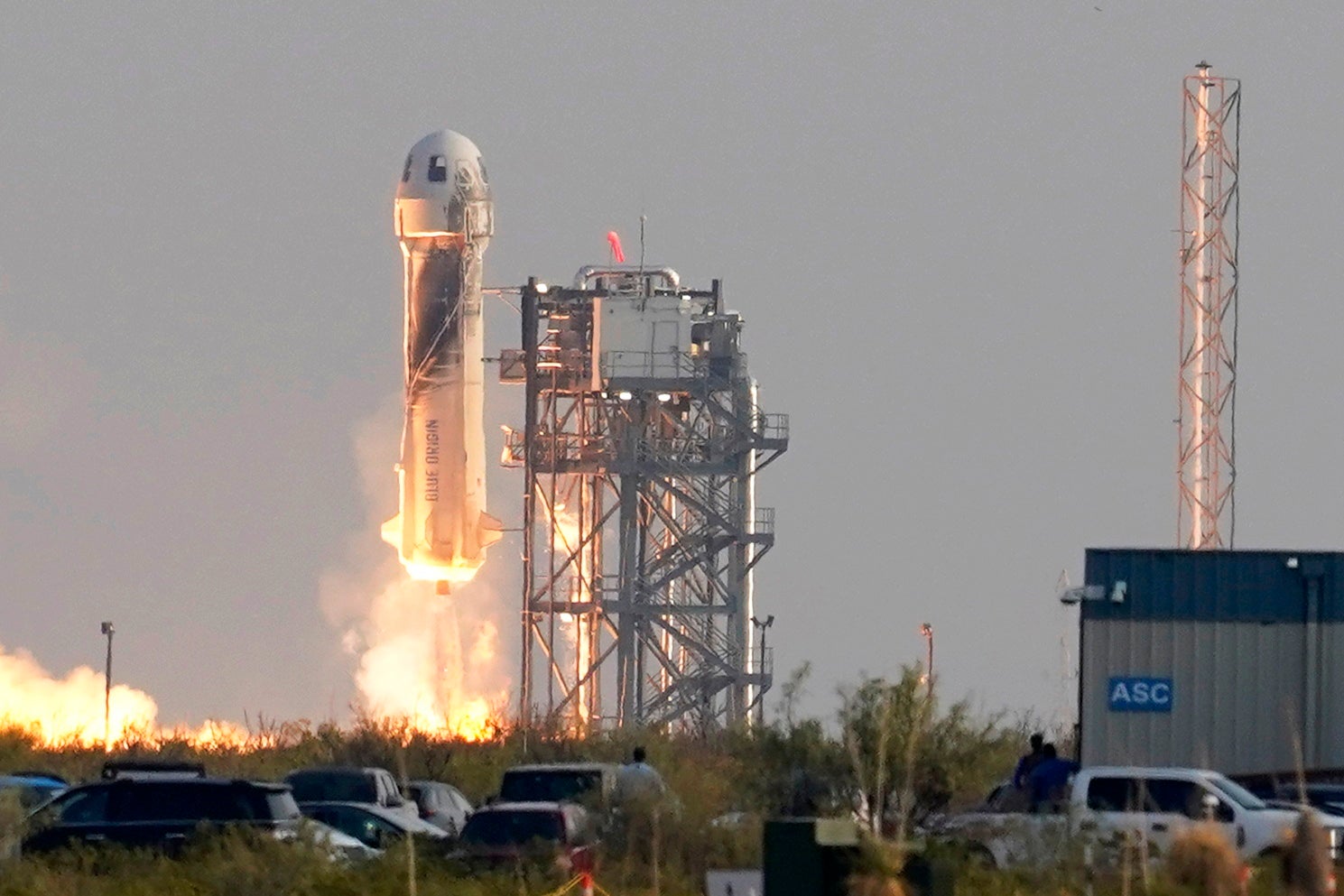How much carbon do Jeff Bezos’s Blue Origin rockets release into space?
Calculating effect of each launch on Earth’s atmosphere will require detailed modelling
Amazon founder Jeff Bezos became the second billionaire to ride his own rocket into space on 20 July when his company Blue Origin’s New Shepard craft blasted off from Van Horn in West Texas.
The businessman was accompanied by his brother Mark, 18-year-old Dutch student Oliver Daemen and 82-year-old aviation pioneer Wally Funk for a 10-minute jaunt into the atmosphere.
During the flight, the capsule reached an altitude of about 106 kilometres after the booster accelerated to three times the speed of sound (Mach 3).
Unlike Sir Richard Branson’s piloted Virgin Galactic rocket plane, which beat Mr Bezos to the punch when it was successfully launched on 11 July, the latter’s capsule was completely automated and required no official staff on board for the flight.
Twelve weeks later, on 13 October, a second Blue Origin flight took off from the same location, this time counting veteran actor William Shatner, 90, among its crew of four, taking Star Trek’s beloved Captain James T Kirk to the final frontier for real and making him the world’s oldest astronaut in the process, comfortably suprassing Ms Funk.
But what toll is all this adventuring taking on the environment?
Scientists say that emissions from rocket engines have historically been seen as small but, as the frequency of launches increases and larger rockets are used, the impact is likely to grow.
Traditional rocket emissions trigger chemical reactions that deplete the ozone layer, experts Martin Ross and James Vedda warned in a 2018 report on the subject.
Space launches also inject particles into the stratosphere that absorb and reflect solar energy, heating the stratosphere while cooling the surface. These thermal changes also lead to the depletion of the ozone layer, their paper said.
However, Blue Origin’s rockets are powered by a mix of liquid hydrogen and liquid oxygen. The propellants are much cleaner than conventional rocket fuel.
Sir Richard’s VSS Unity rocket used a hybrid mix of solid and liquid propellants, while Elon Musk’s SpaceX Falcon project relies on liquid oxygen and a rocket-grade kerosene called RP-1.
Darin Toohey, an atmospheric scientist at the University of Colorado told Live Science that the main emissions from New Shepard would be “water and some minor combustion products, and virtually no CO2”.
However, in a 2019 paper co-authored by Mr Toohey and Mr Ross, the experts warned that “water vapor emissions from individual launches can notably impact the mesosphere and ionosphere”, two much higher layers of the atmosphere.
“Although not presently a global concern, at some increased launch rate, upper atmosphere launch plumes will become ubiquitous and so affect global mesospheric and ionospheric processes and properties,” the scientists said.
The Blue Origin project is designed to use a reusable launch vehicle with landing gear that deploys for touchdown, eliminating the need to build new, resource-hungry rockets and capsules.
Much of the resulting carbon emissions from the space project are likely to result from research and development work, while a significant part of the environmental impact of the launch itself is expected to be from the flights taken by the crew in order to gather in Texas.

Emissions from a one-way flight in economy linking the Netherlands to Texas - the journey undertaken by Mr Daemen, for instance - totals around 0.4 tonnes.
Ultimately, calculating the overall effect of each of these rocket launches on the planet and its atmosphere will require further, detailed studies.
But Eloise Marais, an associate professor in physical geography at University College London, said none of the propellants being used were totally clean.
“Large quantities of water vapour are produced by burning the BE-3 propellant, while combustion of both the VSS Unity and Falcon fuels produces CO2, soot and some water vapour,” she said in an article for The Conversation.
“The nitrogen-based oxidant used by VSS Unity also generates nitrogen oxides, compounds that contribute to air pollution closer to Earth.
“These gases and particles have many negative effects on the atmosphere. In the stratosphere, nitrogen oxides and chemicals formed from the breakdown of water vapour convert ozone into oxygen, depleting the ozone layer which guards life on Earth against harmful UV radiation.
“Water vapour also produces stratospheric clouds that provide a surface for this reaction to occur at a faster pace than it otherwise would.”
The original Blue Origin space trip also attracted lawmakers’ attention, with a proposal to tax the trips just as conventional flights through the troposphere currently are.
On the same day that Mr Bezos blasted into space, Earl Blumenauer, who sits on the US House of Representatives’ tax-writing Ways and Means Committee, proposed legislation that would tax space travel for non-scientific research purposes.
“Space exploration isn’t a tax-free holiday for the wealthy,” the Democrat from Oregon said.
“Just as normal Americans pay taxes when they buy airline tickets, billionaires who fly into space to produce nothing of scientific value should do the same, and then some.”
Join our commenting forum
Join thought-provoking conversations, follow other Independent readers and see their replies
Comments


Bookmark popover
Removed from bookmarks